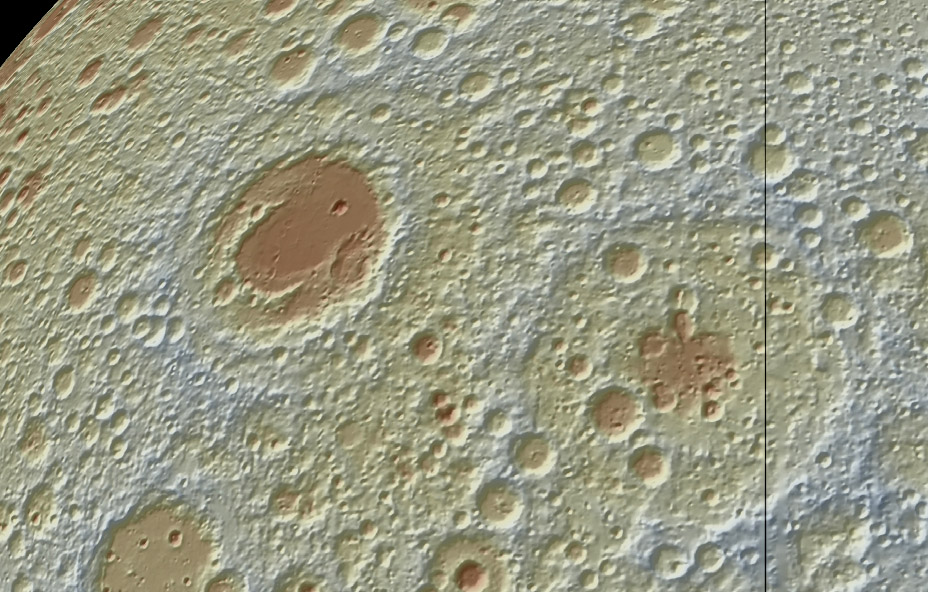Difference between revisions of "November 23, 2009"
| Line 3: | Line 3: | ||
<!-- ws:start:WikiTextHeadingRule:1:<h1> --> | <!-- ws:start:WikiTextHeadingRule:1:<h1> --> | ||
<!-- ws:start:WikiTextLocalImageRule:23:<img src="/file/view/LPOD-Nov23-09.jpg/104604713/LPOD-Nov23-09.jpg" alt="" title="" align="left" /> -->[[File:LPOD-Nov23-09.jpg|LPOD-Nov23-09.jpg]]<!-- ws:end:WikiTextLocalImageRule:23 --><br /> | <!-- ws:start:WikiTextLocalImageRule:23:<img src="/file/view/LPOD-Nov23-09.jpg/104604713/LPOD-Nov23-09.jpg" alt="" title="" align="left" /> -->[[File:LPOD-Nov23-09.jpg|LPOD-Nov23-09.jpg]]<!-- ws:end:WikiTextLocalImageRule:23 --><br /> | ||
| − | <em>visualization of farside Kaguya altimetry data by [mailto:michael.zeiler@yahoo.com | + | <em>visualization of farside Kaguya altimetry data by [mailto:michael.zeiler@yahoo.com Michael Zeiler] (the vertical black line is the 180° meridian)</em><br /> |
<br /> | <br /> | ||
<br /> | <br /> | ||
| − | How many impact basins do you see? There are two obvious ones, the mare in the middle of the Moscovience Basin (left) was discovered at the beginning of the space age by Luna 3, and the [http://the-moon.wikispaces.com/Freundlich-Sharanov+Basin Freundlich - Sharonov Basin] at right is hard to see in normal images, but a mare patch in its center indicated its presence. Both of these basins show up very well in the newly released digital elevation model from Kaguya laser altimeter measurements. This LPOD is a piece of a visualization of that data processed by Michael Zeiler who is a scientist at the ESRI GIS software [http://www.esri.com/ | + | How many impact basins do you see? There are two obvious ones, the mare in the middle of the Moscovience Basin (left) was discovered at the beginning of the space age by Luna 3, and the [http://the-moon.wikispaces.com/Freundlich-Sharanov+Basin Freundlich - Sharonov Basin] at right is hard to see in normal images, but a mare patch in its center indicated its presence. Both of these basins show up very well in the newly released digital elevation model from Kaguya laser altimeter measurements. This LPOD is a piece of a visualization of that data processed by Michael Zeiler who is a scientist at the ESRI GIS software [http://www.esri.com/ company]. Michael's visualization [http://blogs.esri.com/Support/blogs/mappingcenter/archive/2008/10/07/updated-hillshade-toolbox.aspx method] combines shaded-relief presentation with color tints applied to elevation values. As soon as I looked at Michael's farside visualization a larger rim popped out around the Moscoviense Basin - see it? Immediately I thought I had discovered another, more ancient basin that the Moscoviense Basin happened to form in. A little research showed that Dick Pike and Paul Spudis, back in [http://articles.adsabs.harvard.edu/cgi-bin/nph-iarticle_query?1987EM%26P...39..129P&amp;data_type=PDF_HIGH&amp;whole_paper=YES&amp;type=PRINTER&amp;filetype=.pdf 1987] had included a 630 km outer ring for Moscoviense. Shoot! But could these gods of basin ring measurement have erred? This large ring - about 640 km in diameter - is quite off-center, so it is not clear that it is related to Moscoviense. Most basin rings are pretty well concentric, and this must be about the most offset one on the Moon. Or alternatively, it is an older, undetected basin. This is a more exciting interpretation, so temporarily, until we can decide for sure and have something to call it, I anoint it as the Appleton-Tsu Basin, named for the crater Appleton on it's north end, and Tsu Chung-Chi on the south side.<br /> |
<br /> | <br /> | ||
| − | <em>[mailto:tychocrater@yahoo.com | + | <em>[mailto:tychocrater@yahoo.com Chuck Wood]</em><br /> |
<br /> | <br /> | ||
<strong>Thanks to Jim Mosher and Henrik Bondo for the two LPODs when I was out of reach of the Internet!</strong><br /> | <strong>Thanks to Jim Mosher and Henrik Bondo for the two LPODs when I was out of reach of the Internet!</strong><br /> | ||
| Line 17: | Line 17: | ||
---- | ---- | ||
===COMMENTS?=== | ===COMMENTS?=== | ||
| − | + | Register, and click on the <b>Discussion</b> tab at the top of the page. | |
Revision as of 18:05, 17 January 2015
Appleton-Tsu Basin?

visualization of farside Kaguya altimetry data by Michael Zeiler (the vertical black line is the 180° meridian)
How many impact basins do you see? There are two obvious ones, the mare in the middle of the Moscovience Basin (left) was discovered at the beginning of the space age by Luna 3, and the Freundlich - Sharonov Basin at right is hard to see in normal images, but a mare patch in its center indicated its presence. Both of these basins show up very well in the newly released digital elevation model from Kaguya laser altimeter measurements. This LPOD is a piece of a visualization of that data processed by Michael Zeiler who is a scientist at the ESRI GIS software company. Michael's visualization method combines shaded-relief presentation with color tints applied to elevation values. As soon as I looked at Michael's farside visualization a larger rim popped out around the Moscoviense Basin - see it? Immediately I thought I had discovered another, more ancient basin that the Moscoviense Basin happened to form in. A little research showed that Dick Pike and Paul Spudis, back in 1987 had included a 630 km outer ring for Moscoviense. Shoot! But could these gods of basin ring measurement have erred? This large ring - about 640 km in diameter - is quite off-center, so it is not clear that it is related to Moscoviense. Most basin rings are pretty well concentric, and this must be about the most offset one on the Moon. Or alternatively, it is an older, undetected basin. This is a more exciting interpretation, so temporarily, until we can decide for sure and have something to call it, I anoint it as the Appleton-Tsu Basin, named for the crater Appleton on it's north end, and Tsu Chung-Chi on the south side.
Chuck Wood
Thanks to Jim Mosher and Henrik Bondo for the two LPODs when I was out of reach of the Internet!
COMMENTS?
Register, and click on the Discussion tab at the top of the page.



